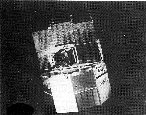The OSO-7 Satellite OSO-7, like the other Orbiting Solar
Observatory missions, was primarily a solar observatory designed to
point a battery of UV and X-ray telescopes at the Sun from a platform
mounted on a cylindrical wheel. The detectors for observing cosmic
X-ray sources were the X-ray proportional counters,
built by MIT, the hard X-ray telescope by UC San Diego and the Gamma Ray
Monitor by the University of New Hampshire.
OSO-7, like the other Orbiting Solar
Observatory missions, was primarily a solar observatory designed to
point a battery of UV and X-ray telescopes at the Sun from a platform
mounted on a cylindrical wheel. The detectors for observing cosmic
X-ray sources were the X-ray proportional counters,
built by MIT, the hard X-ray telescope by UC San Diego and the Gamma Ray
Monitor by the University of New Hampshire.
NSSDC holds the OSO-7 data in their native format. Page authors: Lorella Angelini Jesse Allen HEASARC Home | Observatories | Archive | Calibration | Software | Tools | Students/Teachers/Public Last modified: Friday, 25-Sep-2020 16:48:24 EDT |

